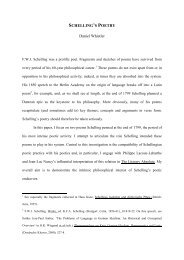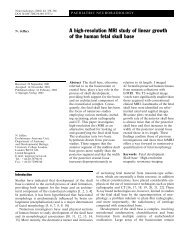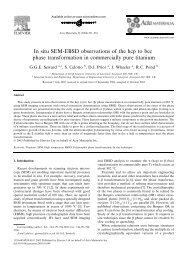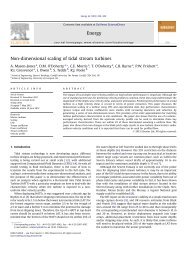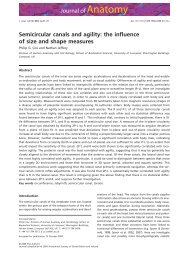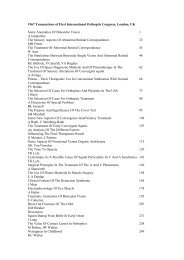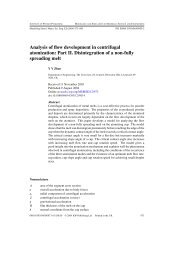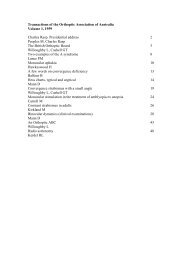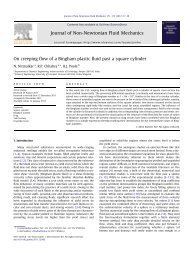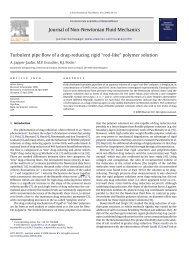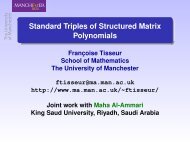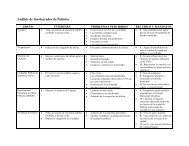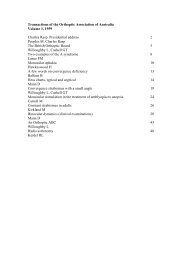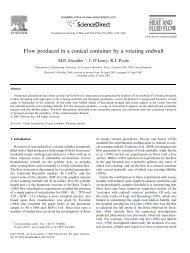Thermal conductivity of porous copper manufactured by the lost ...
Thermal conductivity of porous copper manufactured by the lost ...
Thermal conductivity of porous copper manufactured by the lost ...
Create successful ePaper yourself
Turn your PDF publications into a flip-book with our unique Google optimized e-Paper software.
phys. stat. sol. (a) 205, No. 5 (2008) 1131<br />
<strong>the</strong> cell walls, which in turn increases <strong>the</strong> <strong>the</strong>rmal <strong>conductivity</strong>.<br />
This can clearly be seen in Fig. 5.<br />
If <strong>the</strong> cell walls were defect free solid <strong>copper</strong> and electron<br />
movement were <strong>the</strong> only mechanism for both electrical<br />
and <strong>the</strong>rmal <strong>conductivity</strong>, <strong>the</strong>n electrical <strong>conductivity</strong><br />
and <strong>the</strong>rmal <strong>conductivity</strong> <strong>of</strong> <strong>the</strong> <strong>porous</strong> <strong>copper</strong> samples<br />
would be expected to conform to <strong>the</strong> same power law in<br />
Eq. (4) with an exponent n close to 2. Figure 5 shows that<br />
both <strong>the</strong> variations <strong>of</strong> electrical <strong>conductivity</strong> and <strong>the</strong>rmal<br />
<strong>conductivity</strong> with relative density follow a power law, confirming<br />
that electron movement is <strong>the</strong> main mechanism for<br />
electrical and <strong>the</strong>rmal conduction in <strong>the</strong> cell walls. However,<br />
<strong>the</strong> exponent <strong>of</strong> <strong>the</strong> <strong>the</strong>rmal <strong>conductivity</strong> curve determined<br />
<strong>by</strong> Corsan’s method is lower than that <strong>of</strong> <strong>the</strong><br />
curve determined <strong>by</strong> <strong>the</strong> Sigmatest method. At any relative<br />
density, <strong>the</strong> <strong>the</strong>rmal <strong>conductivity</strong> measured <strong>by</strong> Corsan’s<br />
method is higher than that calculated from electrical <strong>conductivity</strong><br />
<strong>by</strong> Eq. (3). To explain this phenomenon, <strong>the</strong> integrity<br />
<strong>of</strong> <strong>the</strong> cell walls and <strong>the</strong> o<strong>the</strong>r mechanisms contributing<br />
to <strong>the</strong>rmal conduction must also be considered.<br />
In fact, <strong>the</strong> cell walls are not perfect solid <strong>copper</strong> but<br />
contain numerous defects formed during <strong>the</strong> manufacturing<br />
process. There exist low conductive metal oxides, impurities,<br />
cracks and various o<strong>the</strong>r defects within <strong>the</strong> cell walls,<br />
characteristic <strong>of</strong> sintered components. These defects can<br />
largely impede <strong>the</strong> flow <strong>of</strong> electrons and thus significantly<br />
reduce <strong>the</strong> electrical <strong>conductivity</strong>. The measured electrical<br />
<strong>conductivity</strong> is expected to be lower than that predicted for<br />
perfect cell walls and <strong>the</strong> fitted power law has a higher exponent<br />
<strong>of</strong> 2.96.<br />
The <strong>the</strong>rmal <strong>conductivity</strong> in solid walls has ano<strong>the</strong>r<br />
contributing mechanism. In addition to electron conduction,<br />
lattice vibration waves, or phonons, can also transport heat.<br />
While most <strong>of</strong> <strong>the</strong> sintering defects in <strong>the</strong> cell walls are<br />
electrical insulators, <strong>the</strong>y can still contribute to <strong>the</strong>rmal<br />
conduction. In o<strong>the</strong>r words, while radiative heat transfer,<br />
gaseous conduction and convection are all negligible, <strong>the</strong><br />
conduction <strong>by</strong> phonons is not. For <strong>the</strong>se reasons, <strong>the</strong> <strong>the</strong>rmal<br />
<strong>conductivity</strong> values obtained using Corsan’s method<br />
were significantly higher than those converted from <strong>the</strong><br />
electrical <strong>conductivity</strong> values obtained using <strong>the</strong> Sigmatest<br />
method.<br />
4 Conclusions The <strong>the</strong>rmal <strong>conductivity</strong> <strong>of</strong> six opencelled<br />
<strong>porous</strong> <strong>copper</strong> specimens <strong>manufactured</strong> using <strong>the</strong><br />
Lost Carbonate Sintering method was measured and calculated<br />
experimentally, using a novel method developed <strong>by</strong><br />
Corsan. Heat transfer through <strong>the</strong> <strong>porous</strong> <strong>copper</strong> was<br />
dominated <strong>by</strong> conduction in <strong>the</strong> solid phase, with heat<br />
transfer via convection, radiation and gaseous conduction<br />
being negligible. The <strong>the</strong>rmal <strong>conductivity</strong> increases with<br />
relative density and fits <strong>the</strong> power law, with a value for <strong>the</strong><br />
Original<br />
Paper<br />
exponent for <strong>the</strong>rmal <strong>conductivity</strong> <strong>of</strong> 2.05. Electrical <strong>conductivity</strong><br />
<strong>of</strong> five samples, <strong>manufactured</strong> using <strong>the</strong> same<br />
process, was also measured. The electrical <strong>conductivity</strong><br />
values were converted to <strong>the</strong>rmal <strong>conductivity</strong> values using<br />
<strong>the</strong> Wiedemann–Franz law. The as-obtained <strong>the</strong>rmal <strong>conductivity</strong><br />
also increases with relative density and fits <strong>the</strong><br />
power law, with a higher exponent <strong>of</strong> 2.96. The disparity in<br />
<strong>the</strong> <strong>the</strong>rmal <strong>conductivity</strong> values between <strong>the</strong>se two methods<br />
is mainly because <strong>the</strong> sintering defects in <strong>the</strong> cell walls,<br />
such as oxides and impurities make contributions to <strong>the</strong>rmal<br />
conduction but not to electrical conduction. The pore<br />
size <strong>of</strong> <strong>the</strong> <strong>porous</strong> metal does not have any significant affect<br />
on <strong>the</strong> <strong>the</strong>rmal <strong>conductivity</strong>.<br />
Acknowledgements The authors would like to thank<br />
Dr. Liping Zhang for her assistance with sample preparations,<br />
Dr. Chris Sutcliffe and Mr Sozos Stopanos for <strong>the</strong>ir help with <strong>the</strong><br />
<strong>the</strong>rmal <strong>conductivity</strong> measurements and Ecka Granules (UK) for<br />
supply <strong>of</strong> <strong>the</strong> <strong>copper</strong> powder. Mr David Thewsey would also like<br />
to thank <strong>the</strong> EPSRC for a DTA award.<br />
References<br />
[1] G. J. Davies and S. Zhen, J. Mater. Sci. 18, 1899 (1983).<br />
[2] A. F. Bastawros and A. G. Evans, Proc. Symp. on <strong>the</strong> Application<br />
<strong>of</strong> Heat Transfer in Microelectronics Packaging<br />
(IMECE), Dallas, TX, 1997.<br />
[3] H. Degischer and B. Kriszt (eds.), Handbook <strong>of</strong> Cellular<br />
Metals (Wiley-VCH, Berlin, 2002), pp. 222–224.<br />
[4] T. Ogushi, H. Chiba, H. Nakajima, and T. Ikeda, J. Appl.<br />
Phys. 19, 5843–5847 (2004).<br />
[5] N. Babcsán, I. Mészáros, and N. Hegman, Mater.-wiss.<br />
Werkst.tech. 34, 391–394 (2003).<br />
[6] Y. Y. Zhao, T. Fung, L. P. Zhang, and F. L. Zhang, Scr.<br />
Mater. 52, 295–298 (2005).<br />
[7] British Standard: Methods for determining <strong>the</strong>rmal insulating<br />
properties with definitions <strong>of</strong> <strong>the</strong>rmal insulating terms,<br />
BS 874:1973.<br />
[8] J. M. Corsan, Physica E, Sci. Instrum. 17, 800–807 (1984).<br />
[9] W. D. Callister, Materials Science and Engineering – An Introduction,<br />
5th ed. (John Wiley and Sons, Inc., USA, 2000),<br />
pp. 662–665.<br />
[10] J. Kovacik et al., in Proc. Int. Conf. Effect <strong>of</strong> Non-Standard<br />
External Factors on Physical Properties <strong>of</strong> Solids (Military<br />
Academy Liptovsky Mikulas, 1996), p. 57.<br />
[11] J. Kovacik and F. Simancik, Scr. Mater. 39, 239 (1998).<br />
[12] J. Kovacik, Acta Mater. 46, 5413 (1998).<br />
[13] J. Kovacik and F. Simancik, in: Metal Foams and Porous<br />
Metal Structures, edited <strong>by</strong> J. Banhart, M. F. Ash<strong>by</strong>, and<br />
N. A. Fleck (MIT Verlag, Bremen, 1999), p. 303.<br />
[14] D. Stauffer and A. Aharony, Introduction to Percolation<br />
Theory, 2nd ed. (Taylor and Francis, London, 1992).<br />
[15] G. V. Jackson and A. G. Leach, J. Phys. D, Appl. Phys. 26,<br />
740–745 (1993).<br />
www.pss-a.com © 2008 WILEY-VCH Verlag GmbH & Co. KGaA, Weinheim



